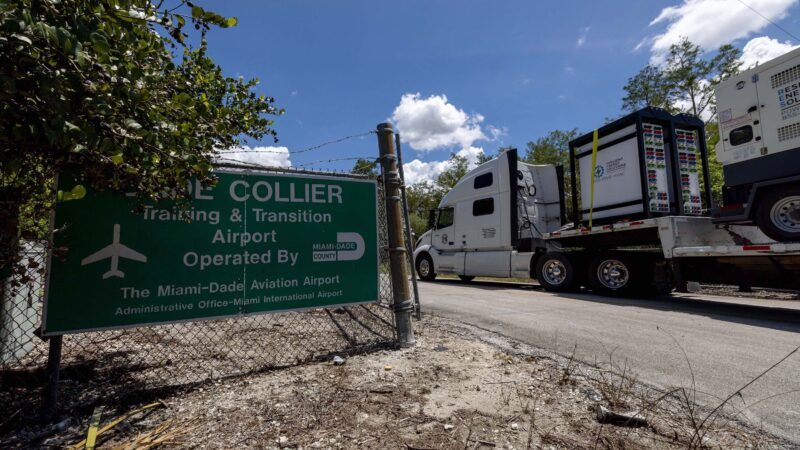The Everglades Jetport Was Supposed To Be a World Wonder. Now It's 'Alligator Alcatraz.'
Our dreams have fallen from supersonic world travel to jailing migrants who've hurt no one.

The government of Florida is proud of how quickly it built a new prison for immigrants. "Eight days, Mr. President," said Gov. Ron DeSantis, grinning, as he stood next to President Donald Trump on the tarmac of the Dade-Collier Training and Transition Airport, which has been converted into a rapid deportation camp. Footage of the camp shared by conservative influencer Benny Johnson showed cages full of bunk beds inside a bare tent.
The airfield was originally designed for much greater things. Founded in the 1960s, the Everglades Jetport was slated to be the largest airport in the world and a hub for supersonic travel. Environmental concerns and the decline of the supersonic jet industry killed the jetport project; only one out of six planned runways was built, and the airport was converted into a training airfield. The final fate of the project—a place for jailing people over bureaucratic offenses—shows just how badly America's political class has forgotten how to dream.
For all its problems, the Cold War was a time of optimism about the high-tech future to come. In the field of air travel, the United States, Europe, and the Soviet Union were all working on supersonic passenger jets; the working assumption on both sides of the Atlantic was that almost all long-haul flights would be supersonic soon. New York and Los Angeles broke ground on airport expansion projects to accommodate supersonic jets. The problem, however, was that these flights caused loud, disruptive sonic booms, a nuisance for anyone living nearby.
Enter the Dade County Port Authority. Officials hoped that the Everglades would be an ideal trans-Atlantic flight hub, both far enough from Miami to avoid sonic booms over populated areas and close enough to service passengers from those areas. Planners envisioned a massive road and rail corridor running from the Atlantic Coast to the Gulf of Mexico through the jetport. The airport itself, carved out of 39 square miles of swampland, would be five times larger than John F. Kennedy International Airport in New York City.
"There are five other states competing for this Jetport," County Commissioner E.W. "Bud" Weaver said at the time. "And we in Palm Beach County are mainly concerned in seeing it does not go out of Florida." A 1968 pamphlet advertising the jetport, which began construction that year, promised that Miami-area airports would serve 35 million passengers by 1985. But construction was shut down two years later. A one-two punch of regulatory concerns killed the project.
First, an unlikely coalition of hunters, environmentalists, and native Miccosukee tribes warned that the transit project "and its attendant facilities" would "inexorably destroy the south Florida ecosystem and thus the Everglades National Park," in the words of a 1969 report commissioned by the Department of the Interior. The website of the National Park Services brags that the 1969 report was the "first ever environmental impact study for the state of Florida."
Second, more general fears about noise pollution dampened enthusiasm for supersonic travel. In 1964, the U.S. Air Force tried to show the public that sonic booms were no big deal by flying supersonic jets over Oklahoma City repeatedly. The experiment backfired, leading to mounting public opposition to supersonic air travel. Congress cut funding for supersonic research in 1971, and the Federal Aviation Administration banned all civilian supersonic flights over land two years later, making the jetport redundant.
Maybe the jetport was never a good idea to begin with. A massive government program to destroy the Everglades sounds like more trouble than it's worth; a better location could have been found. And the world was not yet ready for supersonic air travel, at least economically. The only commercial jet to actually operate regular passenger flights, the Concorde, relied heavily on subsidies from the British and French governments during its time in service from 1976 to 2003.
Still, the dream of supersonic flight for the masses was a noble one. (And some private entrepreneurs think they can get it right this time.) Whether or not the specific location and size made sense, the jetport represented a time when Americans dreamed about a world made more open, better connected, and more efficient by technology.
Alligator Alcatraz represents quite a different vision of efficiency. "You'll be able to bring people in, they'll get processed, they have an order of removal, then they can be queued and the federal government can fly—right on the runway, right there, you literally drive them 2,000 feet, put them on a plane and then they're gone," DeSantis said. Given trends in the Trump administration's deportation strategy, a majority of those people will be migrants who were never convicted of a crime and simply lack papers.
We might not be able to build great things anymore, but we're very good at enforcing paperwork now—and ruining livelihoods in the process.


Show Comments (92)